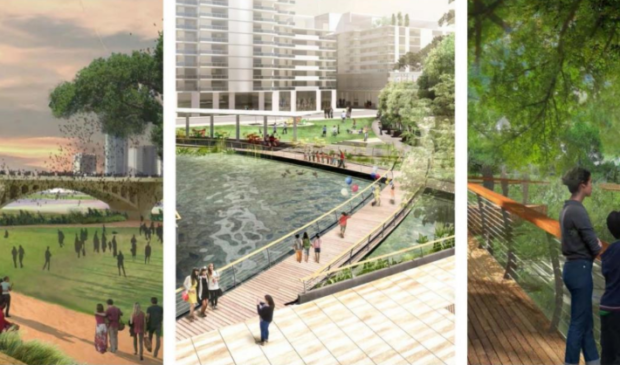About the Author
Chad Swiatecki is a 20-year journalist who relocated to Austin from his home state of Michigan in 2008. He most enjoys covering the intersection of arts, business and local/state politics. He has written for Rolling Stone, Spin, New York Daily News, Texas Monthly, Austin American-Statesman and many other regional and national outlets.
Newsletter Signup
The Austin Monitor thanks its sponsors. Become one.
Most Popular Stories
- Austin’s airport is getting a new concourse and 20 more gates but not until the 2030s
- New rules in the works for electric vehicle charging stations
- Judge rules city can’t use taxpayer money for South Central TIRZ
- Budget deficit looms over city this year and beyond
- Save Our Springs Alliance sues City Council over Open Meetings Act
-
Discover News By District

Waterfront planners push real estate leaders on district’s potential, future
Thursday, May 23, 2019 by Chad Swiatecki
For roughly half a decade, whenever Alan Holt has talked with community members about the scope of the planned South Central Waterfront District – a 118-acre span that could fit 33 city blocks – his shorthand was that it included “everything from Hooters to Joe’s Crab Shack.”
On Wednesday morning, Holt, a planner with the city’s Urban Design Division, admitted to a room full of local real estate leaders that things have changed and he’s had to update his script.
The Hooters restaurant on West Riverside Drive is gone, to make way for the long-brewing “Snoopy PUD” development project. The Joe’s Crab Shack site on East Riverside Drive is for lease as a redevelopment project. And the district as a whole is once again moving through the city’s planning and bureaucratic machinery, with revised budgets and planning documents expected to arrive in front of City Council by September.
At Wednesday’s monthly breakfast of the Urban Land Institute Austin, Holt and two other panelists briefed more than 100 developers, Realtors and other real estate professionals on the 20-year plan for the area south of the Ann W. Richards Congress Avenue Bridge. Recently updated projections for the district, which would include the redevelopment of the Austin American-Statesman property as well as the One Texas Center office building, forecast 8.5 million square feet of retail and residential development worth more than $6 billion by 2040.
The wrinkle in that plan is that the city wants to see an abundance of parks, community plazas and a reorganization of the street grid, with those infrastructure costs expected to total more than $99 million. Paying for those improvements and others will almost certainly require the creation of a tax increment financing plan that would capture increases in property tax revenue to pay off the bond debt for the projects.
Ian Carlton, a project manager for the consulting firm ECONorthwest, said Austin’s district resembles those in other major cities, including Portland, where there is a mix of property owners throughout the district. That dynamic can make it difficult to build consensus around the overall plan and leave late movers facing tougher prospects when trying to sell their property for redevelopment.
“The public sector tries to coordinate activities to create win-win-wins for everyone involved by first coming in and making major public investments that allow those private actors to do things they otherwise couldn’t have done with their properties in the district,” he said. “It becomes like a schoolyard game where so long as the game looks fun and enticing everyone wants to join in, but some people wind up wanting to wait out the game and see if it turns out to be a fun one. We have seen that that kind of activity does not benefit the holdouts.”
Holt said making accessible community assets out of parts of the Texas School for the Deaf and the area at Congress Avenue and Barton Springs Road are examples of the kinds of attractions visitors and an estimated 4,000-plus residents will enjoy as the district is gradually transformed in the coming years.
Asked about traffic in the area as it grows more dense, Holt and Carlton said a combination of small-scale mobility options, increased transit service and the variety of activities for district residents to travel to on foot is expected to reduce the need for cars to travel in and out of the area.
Holt said it will be important for business leaders to step up with participation in public-private partnerships in the district as well as stay involved in the public discourse that will shape how its planning is executed.
“There is a big vision for this area, and it’s a vision unlike any other vision we have in the city of Austin that I know of,” he said. “It’s about how to try to coordinate private redevelopment in partnership with the city and public investments … how that works is complicated. There’s a lot of heavy lifting that’s going to have to happen politically for this to be implemented, so the more people that get involved and understand it, we can break down the friction that arises between neighbors and developers.”
Photo courtesy of the city of Austin.
The Austin Monitor’s work is made possible by donations from the community. Though our reporting covers donors from time to time, we are careful to keep business and editorial efforts separate while maintaining transparency. A complete list of donors is available here, and our code of ethics is explained here.
You're a community leader
And we’re honored you look to us for serious, in-depth news. You know a strong community needs local and dedicated watchdog reporting. We’re here for you and that won’t change. Now will you take the powerful next step and support our nonprofit news organization?









